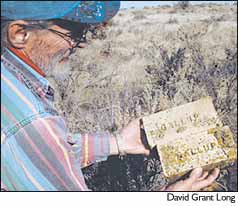Feb. 17, 2000
By David Grant Long Hank Hayne’s rocky love affair started seven years ago when he purchased an historic 60-acre parcel just south of Cortez that has served as everything from the city’s main source of water and fuel to its trash repository. Not to mention as an Anasazi settlement long before the name "Cortez" had any meaning in the New World. "I liked this magic rock when I bought it," Hayne said Tuesday, waving a hand at the expanse of potholed slickrock and sagebrush fields surrounding his home. "Now I love it -- every nook and cranny of it has something special," he said, tears welling in his eyes at the prospect of seeing it suffocated with tract housing or dotted with upscale trophy homes. Developers have made him increasingly attractive offers for the land over the years, Hayne said, and although he’s resisted temptation to this point, he’d like to leave his son a modest inheritance. In other words, everyone has his price. "It comes to the point where the check they wave is too big to turn down -- you know what economic pressure is," said the 62-year-old retired sales manager. The property represents nearly all his financial worth. Still, Hayne said he would be willing to sell the land for preservation at far less than he could get on the market. "I could make this a subdivision and get rich," he said. "But I don’t want to do that -- I would really like to see a park. "I would sell it to the city for less than what it’s worth if they’d make it a park." The land stretches east from Oak Street just south of the city limits and provides unobstructed views of the La Plata Mountains, Mesa Verde and the Sleeping Ute Mountain. It includes Mitchell Springs, site of the area’s first trading post and also its early potable water supply, and is bordered by cliffs running along the north side of McElmo Creek. The property also contains Anasazi ruins that include two Great Kivas, Hayne said, one of which was partially excavated and then refilled many years ago. A graduate student from the Texas Institute of Technology is currently studying the ruins as a research project. "More potsherds and arrowheads are uncovered every time it rains," he said. These relics running the gamut from the early Basketmaker Period to the latter stages of Anasazi culture. "Basically, you have 1600 years of artifacts lying here." Hayne recently took city officials on a tour of his "magic rock" to enlist their support in preserving the land for posterity. City Manager Hal Shepherd said the possibility of acquiring the property intrigued him, but explained that the city has already budgeted all the money in its capital improvement fund for the next few years and that grant money would have to be found to accomplish this. "That’s a very interesting piece of land," Shepherd said Wednesday. "It’s a little premature to say that we’re going to go for a grant or (take a proposal) to council, but I’m interested in seeing if we can do something with it -- I’d like to see it preserved." At the least, Shepherd said, the city would like to obtain a right of way through the northern portion of the land for part of its trail system, which will run along the southern perimeter of Cortez as far as Denny Lake. He said an appraisal would have to be done to determine the market value of the property before any serious negotiations could begin. "It has potential -- we’re just not there yet," he said. "We’ll have to see what we can line up as far as grants -- we’re certainly looking at it." Hayne estimated that the property could bring him as much as $1 million from a developer, but said he would be willing to sell it for $300,000, or about $5,000 an acre, if the city is willing to preserve it for future generations. Hayne’s land has continued to play a key role in the area’s development since prehistoric days, he said. Charlie Mitchell established a trading post near the springs in the 1880s, he said, and supplemented his meager business by selling barrels of water from the springs to Cortez residents. Hayne says he has found a reference to the water being sold for 25 cents a gallon, but believes this was actually the price of a 55-gallon barrel. Three shaft mines in the cliff face also supplied much of the local demand for coal, and early newspaper ads for Mitchell Spring Coal in the Montezuma Journal instructed people "to leave orders at E.R. Lamb & Co. Drug Store in Cortez." A state agency eventually sealed those mines for safety reasons by dynamiting the rock along the top of the cliff, Hayne said. Unfortunately, he added, this explosion also covered a hot springs from which a tall column of steam can still be seen rising during the right weather conditions. But the jumble of giant boulders created by the blasting could easily be removed if the area were made into a park, he said. Another portion of the cliff face is littered with rusting cans and other decaying evidence of a trash dump that was used by city residents for several decades. Hayne has planted a butterfly bush and other vegetation on the dirt that covers the top of the dump site as a "demonstration project" of how this portion could be rehabilitated. |
||
Copyright © 2000 the Cortez Journal. All rights
reserved. |
